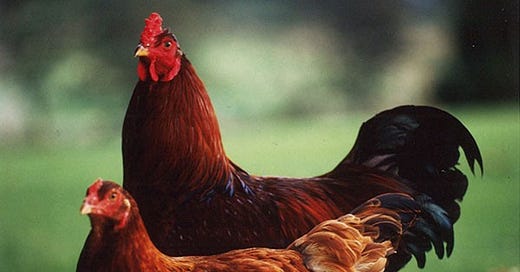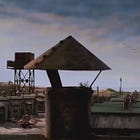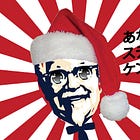As a quick recap to get everyone up to speed, we are discussing chicken in Japan. First, there was no chicken eating, then chickens were a luxury, then the grilled offcuts became popular among the people. For the full read, click below.
Now we have reached post-WWII Japan. A land that didn’t grow up eating chicken but has now become enamoured with the flavour that the bird brings. We arrive at the cusp of a revolution.
Welcome to Part Two of the Chicken Chronicles.
Missing chick alert
What happens when a country demands chickens?
Chicken farmers sell more chickens. If you recall, jidori chickens are native to Japan and were primarily seen as egg laying chickens. It was only during the growing demand that this chicken began its tenure as an animal that was also eaten. And the population rejoiced. The jidoris were incredibly delicious and became famed throughout the country for their tastiness. The consumer was insatiable and new farms were being established across Japan to cash in on this cash chook.
They became regional favourites: Nagoya adopted Chinese-originating Cochin chicken (now also classified as jidori) as its chicken contender; Akita prefecture laid claim to the local Hinai-Jidori, famed for its unique gamey flavour; and Kagoshima prefecture’s Satsuma-Jidori completed the golden trifecta of luxury Japanese chicken breeds. Across the country, they remain revered, and are referred to as the Three Great Jidori. The chicken equivalent of Kobe or Matsusaka Beef. For more on the beef- see my linked article.
However, chickens are not a renewable resource. The chicken farming technology of the Meiji period had certainly not accounted for the 1950s era demand for the animal. Slowly, then rapidly, the native jidori population plummeted. Even the three legendary breeds were not immune. Like many species before them, they were eaten into extinction. Only through the miracle of cross-breeding can we taste a semblance of this historical chickens as they once were. Nowadays, a chicken must have at least 50% of their bloodline matching the classical breed to be classified as being a Great Jidori. The other half can be American, proving that at least among chickens, Japanese society is willing to accept foreigners. One exception is the Nagoya Cochin, still a pure breed bird.
After all is said and done, these great birds only account for 1% of chickens in Japan today, and exist in the luxury market. So what has allowed for the mass consumption of chickens to continue in ever-growing numbers? Again we can turn to the USA.
No clucks left to give
This is going to get academic, with graphs and citations from the Historical Overview of Poultry in Japan. By the 1960s, meat production in general steadily grew, starting with pork and expanding with the other two beloved farm animals of chicken and beef. For a time, as everyone in Japan was living in an economic miracle mindset, all joined in this meat eating frenzy. So it wasn’t clear which of the three proteins would cement its place as Japan’s favourite. In the end, chicken (or more accurately, the chicken producers) crows triumphantly as the most common meal on Japanese plates.
If your graph reading abilities are sufficient, you’ll see the sharp and sustained rise in 1960’s for for pork and chicken particularly. Both benefitted from the general increased taste for meat. Pork especially was a traditional favourite in Japan and had established pork farms to meet this expected demand. Chicken was a different story, and by 1960 was already at its peak capacity using the native birds. Yakitori was a new favourite food and there just weren’t enough chickens to provide even the discarded offcuts.
American arrivals
With a title like that, it must be time for Colonel Harlan Sanders. Before we count our chicks prior to hatching, a confluence of domestic and international events needed to happen for chickens to be eaten at the unprecedented scale they are today.
How did America come into this and save the Japanese consumer from not enough chicken?
Strut forward the broiler chicken.
Scientific name: Gallus Gallus Domesticus
Description: White chickens bred specifically for meat production. These birds get under 50 days to grow to be a good edible weight of 2-3 kilograms! Shipped in from America, this breed of chicken is likely the same one you eat at home.
Arrival status: During the American occupation of Japan, they brought with them their wily ways of extracting more meat from fewer chickens. This piqued the interest of local industrial firms who saw a land where chickens were aplenty and said “we need more!”. This marked the start of another industrial revolution (in chickens). The early 1960s saw everything to do with chickens imported from the USA. This meant the actual animals, the feed, the processing machines, and even the means of distribution. In under a decade, broilers were a mainstream meal, and became the dominant food-bird.
Kentucky’s finest
By the late 1960s, Japan had an entirely new chicken processing system in place, so a certain Colonel felt a disturbance in the force. Like an apex predator being introduced to a turtle hatchery, Harlan Sanders would be lickin’ his fingers as he sensed a country without any American-style fast food. Even better that they already had the US production line of chickens ready to fry.
This looked like opportunity with untapped markets galore, but there still remained a challenge for KFC. Was the lack of US fast food in Japan because no one had thought of it, or was it because Japanese people didn’t want it?
The answer might be clear today, but at the time it made sense to try and engage with a more local Japanese company to test and explore the appetite. So in 1969, the world’s most important project was finally launched. That’s right, KFC was entering a 15-year long joint venture with the obvious fast food partner, Mitsubishi! It was time to see if American fried chicken could take flight in Japan. Also in 1969, some people walked on a big rock in space.
The timing was perfect. Osaka in 1970 was hosting the World’s Expo, which at the time was very important and meant lots of domestic visitors at a single location. With the Expo running from March to September, the hope was that this would give the Kentuckians time to integrate for the locals to accept them.
Mitsubishi/KFC were granted a place to run their pop-up store in the American Park, yet even this very American shopfront in an American Park was already changed to meet Japanese needs. The store was one quarter the size of an American KFC.
In terms of pure sales numbers, this one store exceeded all possible expectations. The tiny expo shopfront for a period had the most sales of any store globally. Yet the leadership were reluctant to base an entire national launch of a company on the outcome of a once-a-generation festival that also attracted international visitors.
That meant Americans. A well documented survey of American cruise tourists at the time found that among the thousand restaurants at the 1970 Osaka World Fair, 46% of cruisers claimed that KFC was the best spot to eat. What this suggests is Americans really like Kentucky Fried Chicken. This was not a helpful insight for the executives, as it was not exactly a secret and they didn’t need to cross continents to learn this.
Beyond the crowds of American tourists who know and love the red and white stripes, the domestic findings had troubled Mitsubishi. The technical director noted that certain US flavour profiles didn’t work in Japan, such as the “sugar content in salad” needing to be cut in half. Despite the local distaste for typical staples like mashed potato and gravy, or bread rolls, the joint venture saw enough over the Expo to try and launch a permanent standalone KFC store.
Would the clucky young startup find its feet in Japan?
While there may not be any suspense on whether KFC survives in Japan (it does), join us next week for the next installment of the Chicken Chronicles. Follow and share Hidden Japan to keep learning more on the fried chicken story!
Continues here at:











Thanks for another fascinating look at Japan's meaty post-war history.
I remember reading a fascinating article many years ago about how the flows of exported and imported chicken meat between China and the USA by processors (Tyson Foods?) would change and reverse direction regularly throughout the year as a result of changing consumption patterns, which depended at least partly on sport. IIRC, there is an American tradition of eating chicken wings while watching football or baseball or something. Meanwhile, the chicken feet go to China, with or without the drumsticks - I can't remember! I do remember that the complexity and efficiency of Tyson's operation was quite impressive.
Great article!
By chance I was watching a documentary about Expo 70 the other day; I had to go back and scrub through to see if I had missed any KFC content. Unfortunately the only thing included about the American pavilion was the arrival of the actual Apollo 8 crew capsule.